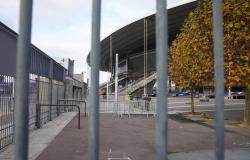Thibaut de Saint Chamas is a photographer based in Paris, France. He discovered photography just before graduating from Sciences Po Paris and decided to change course and abandon a secure and predictable career for a precarious but creative life. After a stint in Vienna, Austria, he joined the National School of Decorative Arts. Where he acquires a visual and artistic culture and learns the importance of transdisciplinary inspiration.
This current personal work and new book publication is titled And we remain some absent with Paris as the subtitle on the photo cover. For five years, de Saint Chamas has been carrying out a patient and systematic photographic study of Paris. While this work represents a snapshot of the city as it has undergone major transformations in the run-up to the Olympic Games, its primary objective is to capture the exceptional atmosphere and spirit of places steeped in culture and history. Bringing emblematic places into dialogue with less emblematic ones, it tells the story of the moods and atmospheres of this city at a time when most are asleep.
His photos address the notions of intimacy, the road, mystery and the “non-spectacular” where the setting becomes the main character of a secret and fictional piece. He is also working on another long-term project on the forgotten villages of France presented during the Rencontres de la Photographie in Arles.
He began his career creating portraits of anonymous and famous people. For magazines (Télérama, Madame Figaro, Lire) or personal projects, he seeks to bring out the most impactful angles and attitudes of his models. This experience proved valuable when he began photographing beauty and fashion in the 2000s for ELLE and Vogue Paris. When he is not working in Paris, he also regularly produces travel journals in Burma, Syria, the Baltic States, the Norwegian North Cape and Nicaragua.
As comfortable with sophisticated studio work sessions as he is with candid photography on the go, ELLE USA asked him to take behind-the-scenes photos at fashion shows in a precise yet spontaneous way. This gives her the opportunity to meet many creative and talented artists and hone her sense of beauty, style and fashion. Thibaut opened his own workshop in a heritage building in the Montorgueil district.
He works for various fashion brands such as Christian Dior, Giorgio Armani, YSL… for campaigns, editorial content and deciphering trends.
His photos appear in Giorgio Armani (Rizzoli) Life under my skin (Diesel) Azzaro 50 years of brilliance et Lolita Lempicka 20 years of creationn, Lamartinière editions, Mouna Ayoub journey of a collector, American Style (Assouline)
Website: http://desaintchamas.com
Book: And we remain a few absent – Paris (Release November 5, 2024 Editions Odyssée)
Social Media: ig designchamas
Patricia Lanza: How did you decide to carry out the project and work in PARIS?
Thibaut de Saint Chamas: As I had to take early morning flights or trains, I had to cross the city very early and I was always struck by its atmosphere and calm which contrasts sharply with the daytime ambiance.
Paris is a complicated subject. It's stunning and as such has been widely photographed. My goal was not to once again celebrate its beauty. I wanted to explore what is beyond that. I was more interested in its fictional side, its atmosphere which can change radically from one moment of the day to the next. I also wanted to explore the fine line between what seems familiar and what becomes surreal when you pay closer attention.
So from one block to the next, I began to explore the city during that elusive and fragile moment when everyone is asleep. Regularly, again and again, with different weather and light conditions.
Describe your process of working in the city and your choice of locations?
Thibaut de Saint Chamas: Paris is a mixture of different villages with invisible borders from one street to another. As you pass a street or intersection, you enter a different style of architecture, stories and ambiance. I proceeded at a much slower pace than we usually walk at during the day. The photographic process itself was very slow, with particular attention paid to composition, angle of view and the balance between what is shown within the image and what is suggested to the exterior. My goal was not to document the city (even if it witnesses a certain moment in its long history, its architecture and its urban planning). My goal was to show the setting as the main character of a play in which the passage of time, the mystery of the ordinary and absence share the main roles. Melancholy too, as long as we define it as the happiness of being sad.
It was more the mix of buildings that attracted me than the buildings themselves. As with people, the way buildings and their surroundings interact with each other creates a certain charm and attraction and speaks volumes. It also brings out a certain visual vocabulary that is inseparable from Paris: the skyline, perspective and the sense of wide open spaces. On the other hand, small details and “accidents” play an important role. As in Japanese wabi sabi, the elusive beauty of imperfection, they are welcome and necessary. They convey the feeling of being anchored in present time and in real life. Construction fences, billboards, a parked car, time that has left its mark on a dilapidated wall or papers lying on the sidewalks can all be felt as insignificant compared to the eternal beauty of the city. But they are decisive in the construction of this beauty and welcoming for their capacity to give life, suggesting the vestiges of time and conveying the aesthetics of today. For the same reason, I made no distinction between emblematic places and vernacular places. They need each other. As long as they relate to stories and moments of life.
Your work is devoid of people giving it a timeless atmosphere, how did you arrive at this approach?
Thibaut de Saint Chamas: Due to the time of day, most of my photos are devoid of humans. On closer inspection, however, some appear in certain images. As with the “accidents”, I wanted this tension between the “big image” and the pixel, the small detail. With reading in two stages, one fast and one slow. The human appears as an echo of the past day or the promise of the next. They seem overwhelmed by the grandeur of the city, elusive as are our destinies when considered on a historical scale. But at the same time, they are what this city is: a crossroads of destinies. The absence of humans allows us to concentrate on the decor and gives this feeling that the city is ours. An exhilarating feeling of an in-between moment where the past is gone and the future has not yet arrived and anything is possible.
When photographing I had in mind the atmospheres of the New Wave films or the films of Michelangelo Antonioni like The Night but also the surreal or meditative atmospheres of Giorgio De Chirico or René Magritte. Some images also echo the surrealist Pope André Breton and his emblematic novel Nadiawhich recounts the meeting of a mysterious woman called Nadja in a surreal Paris.
Give details of publication dates. What are you looking to do with this work beyond publishing a book?
Thibaut de Saint Chamas: And there are still a few of us missing – Paris. Odyssey Editions. Regular edition available from November 5 plus Collector's Edition signed copies plus an art print numbered from 1 to 40 (4 sets of 10).
Texte & Interview by Patricia Lanza
Thibaut de Saint Chamas: And we remain some absent – Paris
Odyssey Editions
https://www.editionsodyssee.com/paris






